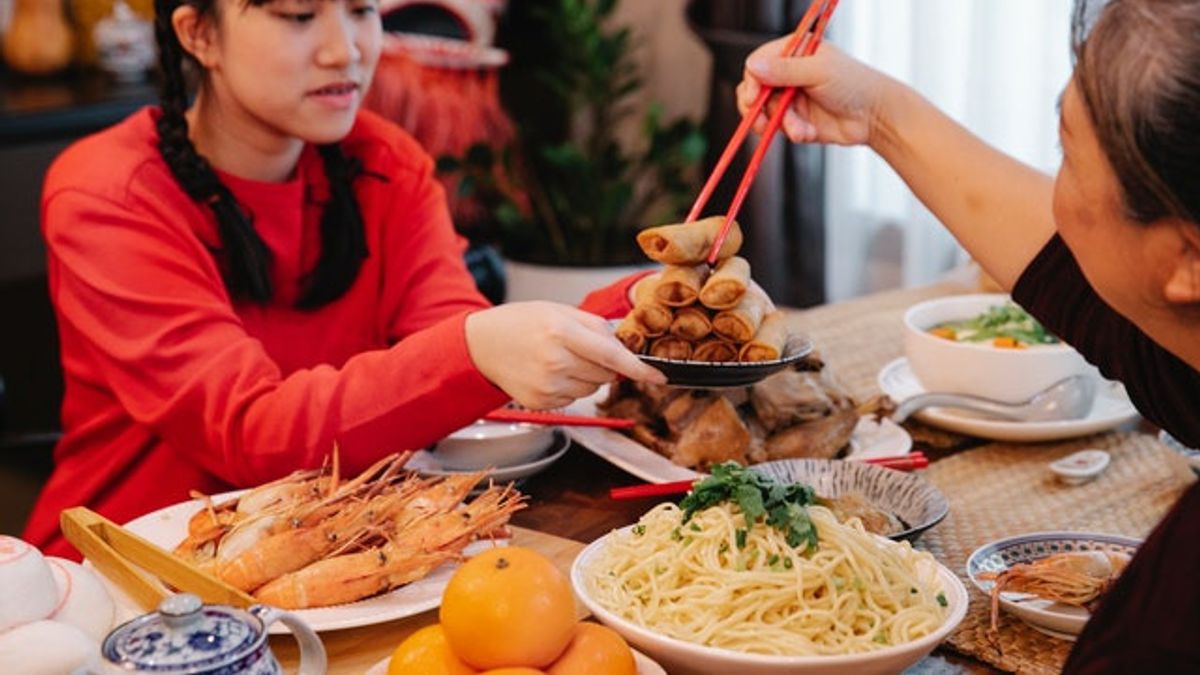JAKARTA - Soon, Chinese citizens around the world will celebrate a big celebration, namely the Chinese New Year. This celebration is synonymous with red ornaments and red packets or envelopes filled with money given as gifts.
In addition to the two things above, there are also special foods that are only provided during Chinese New Year. This food is specially served for family and close relatives. If you are not familiar with these menus, here are some typical Chinese New Year foods that are mandatory menus and their meanings.
Jiaozi Jiaozi is baked dim sum. The filling is in the form of vegetables such as chives, chicory or cabbage which is cut into thin slices and meat. If served during Chinese New Year, the meat used is pork. On weekdays, chicken and beef are used as substitutes. Eating Jiaozi during Chinese New Year symbolizes the hope of abundance of sustenance and harmony in the family.
Jiaozi is baked dim sum. The filling is in the form of vegetables such as chives, chicory or cabbage which is cut into thin slices and meat. If served during Chinese New Year, the meat used is pork. On weekdays, chicken and beef are used as substitutes. Eating Jiaozi during Chinese New Year symbolizes the hope of abundance of sustenance and harmony in the family.
 Siue Mie is fried noodles served without being cut into pieces. Mi deliberately left long as a symbol of longevity. No wonder Siu Mie is also called Longevity Mi or Changsshou Mian. Siu Mie is cooked in a little oil to prevent the noodles from clumping.
Siue Mie is fried noodles served without being cut into pieces. Mi deliberately left long as a symbol of longevity. No wonder Siu Mie is also called Longevity Mi or Changsshou Mian. Siu Mie is cooked in a little oil to prevent the noodles from clumping.
A typical Chinese New Year dish that is widely known is Cake Basket or Nian Gao. Eating Basket Cakes on Chinese New Year means wishing for a more prosperous year. Basket cakes are usually arranged on a red cupcake or on a large tray. This presentation signifies that the host is ready to receive a full year of prosperity.
Yusheng Yushen is a must-have meal during Chinese New Year. This is a meal served on a large plate of sliced salmon, carrots, radishes, cabbage, candied oranges, and plums with sesame sauce.
Yushen is a must-have meal during Chinese New Year. This is a meal served on a large plate of sliced salmon, carrots, radishes, cabbage, candied oranges, and plums with sesame sauce.
Before eating Yusheng, it must be accompanied by a prayer of gratitude for the sustenance that has been given. The accompaniment prayer aims for the family who eats Yusheng to be given better sustenance in the new year.
Santang OrangeAs a dessert, Santang oranges or mandarin oranges are also obligatory to be on the dining table during a big meal on Chinese New Year's Eve. Oranges signify abundance of sustenance, prosperity, and well-being.
Lapis legit cakeNot only present during Lebaran, the Legit layer cake also seems to be a mandatory food menu during Chinese New Year. Lapis legit has a special meaning, namely the hope that sustenance will come double, like the shape of a layered layer cake.
Fried Spring Rolls In Cantonese, spring rolls are also called chun juan. The color and shape of spring rolls is considered to be similar to gold bars which symbolize wealth.
In Cantonese, spring rolls are also called chun juan. The color and shape of spring rolls is considered to be similar to gold bars which symbolize wealth.
There are two types of special sweets served during Chinese New Year. First, the sweet rice balls are round and white. Second, candied square eight with eight different variants. Candied square eight is often referred to as a tray of happiness, because this food is a typical Chinese New Year food which has a meaning of prosperity.
Sauteed Green VegetablesGreen vegetables must also be present at meals during Chinese New Year. Green vegetables are usually cooked by sauteing with additional meat or simply sauteing in vegetable oil. The vegetable menu symbolizes harmony and luck. Green vegetables also signify a prayer for parents for a healthy and long life.
Boiled Eggs in Soy SauceEggs boiled in soy sauce and tea are the last dishes served by Chinese families when celebrating Chinese New Year. This boiled egg has the meaning of fertility. So, the hope is that whoever eats boiled eggs during Chinese New Year can have many children.
The English, Chinese, Japanese, Arabic, and French versions are automatically generated by the AI. So there may still be inaccuracies in translating, please always see Indonesian as our main language. (system supported by DigitalSiber.id)












